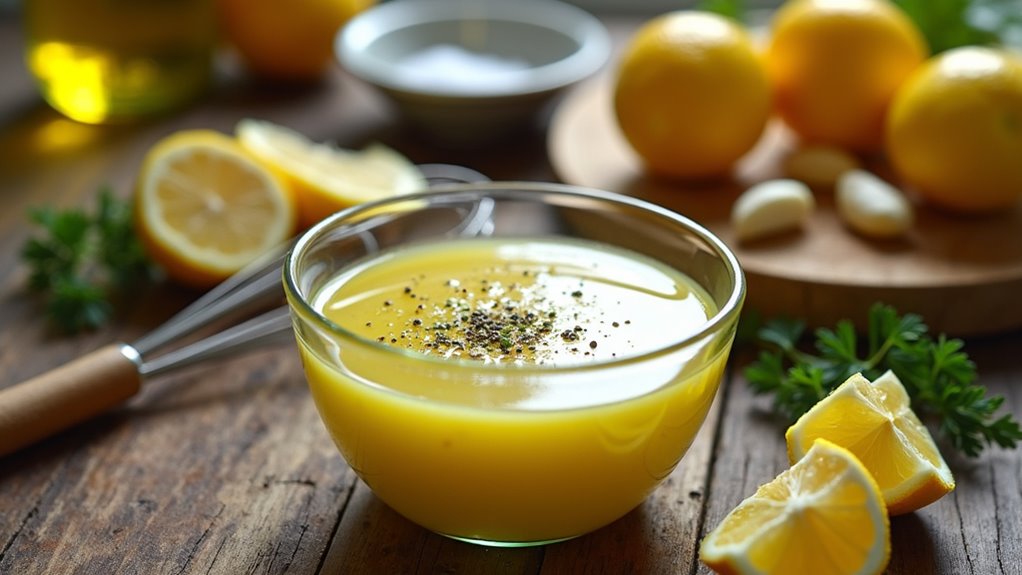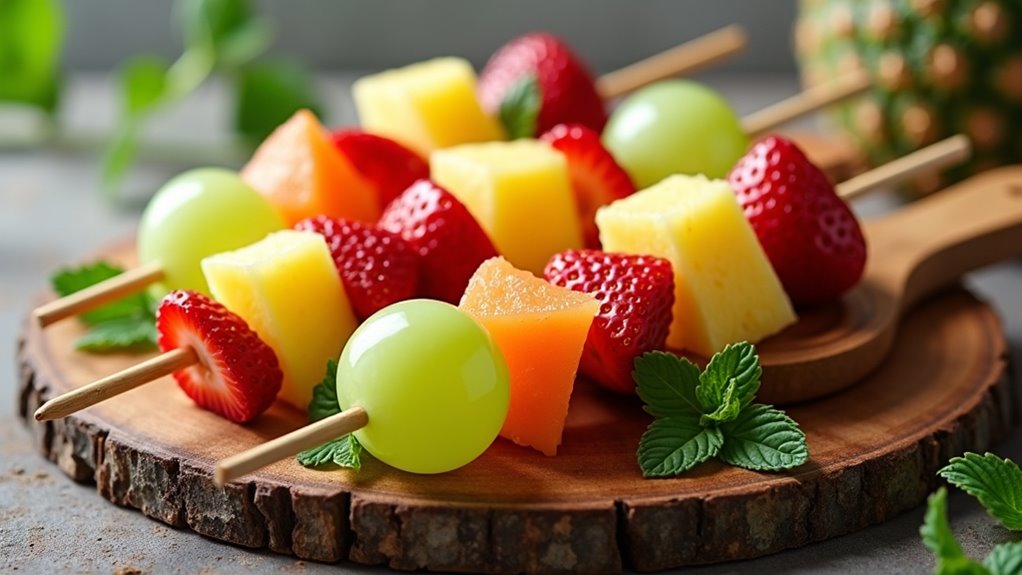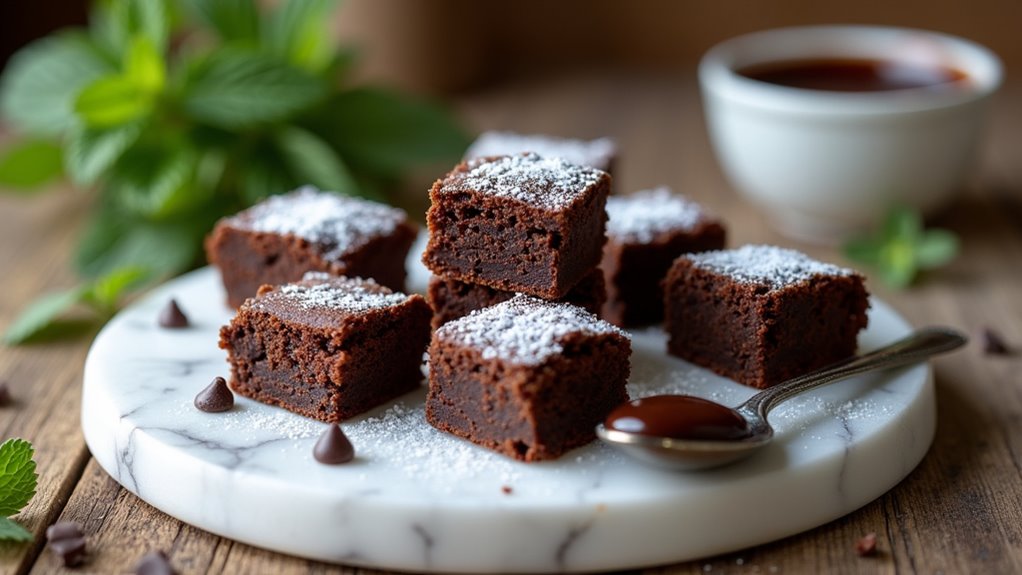A frantic call from my sous chef interrupted my prep routine. “Chef, that food critic just sent back her salad—says the dressing is ‘uninspired’!” I smiled, grabbing lemons from our kitchen garden. “Time for my secret weapon.” Within minutes, I whisked together a bright vinaigrette that transformed those simple greens. When the plate returned empty, I knew we’d won her over. That’s the power of a proper lemon vinaigrette—it turns the ordinary into something worth writing about.
History & Origin
Although vinaigrettes have ancient roots tracing back to Roman culinary practices, the lemon vinaigrette represents a vibrant evolution of traditional dressing techniques.
Mediterranean cuisines perfected this tangy vinaigrette by combining fresh lemon juice with high-quality olive oil, creating a versatile flavor profile that transforms simple salads.
The origins of this dressing connect directly to ancient vinegar-based preparations, where cooks skillfully blended acidic and oil components.
Lemon vinaigrette emerged as a culinary innovation, transforming how chefs approach dressing preparation by introducing bright, citrusy notes that complement diverse ingredients and enhance natural food flavors.
Recipe

A perfect lemon vinaigrette is a culinary essential that transforms simple salads into extraordinary dishes. With just a few fresh ingredients, you can create a bright, zesty dressing that elevates everything from leafy greens to roasted vegetables.
This homemade vinaigrette is incredibly simple to prepare and offers a perfect balance of tangy lemon, rich olive oil, and seasonings. By whisking together fresh ingredients, you’ll create a versatile dressing that can be customized to suit your taste preferences and complement a wide variety of dishes.
Ingredients
- 1/4 cup fresh lemon juice
- 1/2 cup extra-virgin olive oil
- 1 teaspoon kosher salt
- 1/2 teaspoon freshly ground black pepper
- 1 clove garlic, minced (optional)
- 1 teaspoon Dijon mustard (optional)
- 1 teaspoon honey or maple syrup (optional)
Equipment
- Whisk
- Measuring cups
- Measuring spoons
- Airtight container or jar
- Cutting board
- Knife
Instructions
- Juice fresh lemons to obtain 1/4 cup of juice
- Mince garlic if using
- Add lemon juice to a mixing bowl
- Add salt and pepper
- Add minced garlic, Dijon mustard, and honey (if using)
- Slowly drizzle in olive oil while continuously whisking
- Whisk until mixture is fully emulsified and smooth
- Transfer to an airtight container
- Refrigerate for up to one week
Nutrition
70 kcal | 1g Carbohydrates | 0g Protein | 8g Fat | 1g Saturated Fat | 1g Polyunsaturated Fat | 6g Monounsaturated Fat | 0mg Cholesterol | 120mg Sodium | 10mg Potassium | 0 IU Vitamin A | 5mg Vitamin C | 2mg Calcium | 0mg Iron
Cooking Tips
When preparing the vinaigrette, whisk continuously while adding olive oil to ensure a smooth, well-combined dressing. For best results, bring the vinaigrette to room temperature and give it a good shake or whisk before serving to reincorporate any separated ingredients.
Serving Suggestions
Lemon vinaigrette’s versatility shines when paired with a variety of dishes. For a light lunch, drizzle it over a bed of mixed greens with grilled chicken and toasted almonds, or use it to transform a simple grain bowl into a vibrant meal.
The bright, tangy dressing works beautifully with roasted vegetables like asparagus or Brussels sprouts, cutting through their richness and adding a fresh dimension. When marinading proteins, allow chicken or fish to sit in the vinaigrette for 30 minutes before cooking to infuse maximum flavor, and consider garnishing the final dish with fresh herbs like parsley or basil for an extra layer of complexity.
Common Mistakes & Troubleshooting
One common error when preparing lemon vinaigrette is over-emulsifying the dressing, which can make it too thick or dense. I once made this mistake by vigorously whisking the ingredients, resulting in a mayonnaise-like consistency instead of a light, pourable dressing.
To prevent this, whisk gently or use a jar with a tight lid to shake the ingredients, allowing them to combine naturally. Another potential pitfall is using bottled lemon juice instead of fresh – the difference in flavor is significant, so always opt for freshly squeezed lemons to achieve the brightest, most authentic taste.
Frequently Asked Questions
How Do You Make Ina Garten’s Lemon Vinaigrette?
I whisk fresh lemon juice with salt and pepper, then slowly drizzle in olive oil while mixing. It’s simple, delicious, and I love how it transforms my salad with bright, zesty flavor in just minutes.
What Is Lemon Vinaigrette Made Of?
I whip up lemon vinaigrette using fresh lemon juice, extra-virgin olive oil, Dijon mustard, and minced garlic. Sometimes, I’ll add a touch of honey to balance the zesty acidity and create a perfectly smooth, tangy dressing.
How to Make a Gordon Ramsay Vinaigrette?
I’ll whisk fresh lemon juice with Dijon mustard, then slowly drizzle in high-quality olive oil while seasoning. I’ll add minced garlic or herbs for extra flavor, creating a zesty, versatile dressing that’ll elevate any salad or grilled dish.
What Is the Ratio of Lemon Juice to Olive Oil for Dressing?
I typically use a 1:2 ratio of lemon juice to olive oil, but you can adjust it to your taste. For a tangier dressing, I’ll go 1:1. The key is whisking thoroughly to create a smooth, well-blended vinaigrette.
In Conclusion
This lemon vinaigrette recipe will transform your salads with bright, zesty flavor. The balance of tangy lemon, smooth oil, and subtle seasonings creates a versatile dressing that complements almost any dish. Remember that you can adjust the ingredients to suit your taste preferences – more garlic for intensity or additional herbs for complexity.



